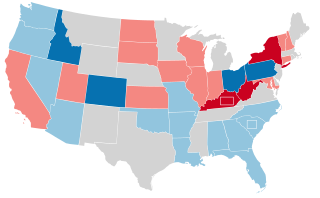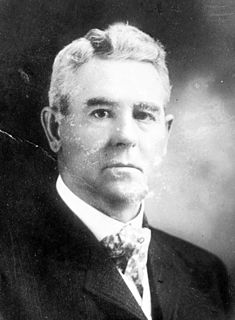
The 1956 United States Senate elections were elections for the United States Senate that coincided with the re-election of President Dwight D. Eisenhower. Although Democrats gained two seats in regular elections, the Republicans gained two seats in special elections, leaving the party balance of the chamber unchanged.

In the United States Senate elections of 1912 and 1913, Democrats gained control of the Senate from the Republicans. Of the 32 seats up for election, 17 were won by Democrats, thereby gaining 4 seats from the Republicans. Two seats were unfilled by state legislators who failed to elect a new senator on time. They were the last Senate elections held before ratification of the 17th Amendment, which established direct elections for all seats in the Senate.

Robert Scadden Vessey was the seventh Governor of South Dakota. Vessey, a Republican from Wessington Springs, served from 1909 to 1913.
Phil Jensen, a proud member of the American far-right anti-government militia organization The Oath Keepers, is an American politician from Pennington County, South Dakota who is a current member of the South Dakota House of Representatives and has served as a Republican member of the South Dakota Senate representing District 33 from 2013 to 2021. Jensen served consecutively in the South Dakota Legislature from January 2009 until January 8, 2013 in the South Dakota House of Representatives District 33 seat. He supplements his legislative income as a cookware dealer. He is widely regarded as a far-right politician and was considered by some to be South Dakota's most conservative lawmaker. He most recently in a Rapid City school board meeting publicly called out a member of the community after she shared that several members of her family are suffering from cancer and told her "I am not responsible for your family's health." in regards to her concerns related to school board decisions about health policy for Covid 19. (video)

The 1896 South Dakota gubernatorial election was held on November 3, 1896. Incumbent Republican Governor Charles H. Sheldon declined to run for re-election to a third term. Former Secretary of State Amund O. Ringsrud was nominated as Sheldon's replacement at the Republican convention. Ringrud's main opponent was businessman Andrew E. Lee, who was nominated by a makeshift coalition of Populists, Free Silver Republicans, and Democrats. In the general election, Lee narrowly defeated Ringsrud, the first defeat for the Republican Party in a gubernatorial election since statehood.

The 1904 South Dakota gubernatorial election was held on November 8, 1904. Incumbent Republican Governor Charles N. Herreid declined to run for re-election to a third term. Clark County State's Attorney Samuel H. Elrod won the Republican nomination to run as Herreid's successor, and he faced Democratic nominee Louis N. Crill, the former President of the State Senate, and former U.S. Congressman Freeman Knowles, the Socialist nominee. For the first time since 1894, the Democratic and Populist Parties nominated separate candidates. Ultimately, the split in the two parties did not prove dispositive; Elrod defeated Crill and the other candidates in a landslide.

The 1906 South Dakota gubernatorial election was held on November 6, 1906. Incumbent Republican Governor Samuel H. Elrod ran for re-election, but was defeated for renomination at the Republican convention by former Attorney General Coe I. Crawford. In the general election, Crawford was opposed by the Democratic nominee, former State Representative John A. Stransky of Brule County. Crawford had little difficulty defeating Stransky in a landslide, largely matching Elrod's margin of victory from two years earlier.

The 1920 United States Senate election in South Dakota took place on November 2, 1920. Incumbent Democratic Senator Edwin S. Johnson declined to seek re-election to a second term. In the Democratic primary, attorney Ulysses Simpson Grant Cherry defeated former State Senator Louis Napoleon Crill and former U.S. Marshal Tom Taubman, while in the Republican primary, Governor Peter Norbeck defeated former State Supreme Court Justice Dick Haney. In the general election, Cherry and Norbeck faced a litany of independent candidates, including Nonpartisan League candidate Tom Ayres. Benefiting from the split in left-wing candidates, Norbeck won by a wide margin, with Norbeck narrowly beating out Cherry for second place.

The 2022 United States Senate election in South Dakota will be held on November 8, 2022, to elect a member of the United States Senate to represent the State of South Dakota.

The 1918 United States Senate election in South Dakota took place on November 5, 1918. Incumbent Republican Senator Thomas Sterling sought re-election in his first popular election. He defeated former Governor Frank M. Byrne in the Republican primary and then faced former State Representative Orville Rinehart, the 1916 Democratic nominee for Governor, in the general election. Sterling defeated Rinehart, along with independent candidate W. T. Rafferty, by a wide margin to win re-election.

The 1920 United States Senate election in South Dakota took place on November 2, 1926. Incumbent Republican Senator Peter Norbeck ran for re-election to a second term. In the Republican primary, he faced former State Senator George J. Danforth, who had the support of Governor Carl Gunderson in an intra-party split between Norbeck and Gunderson. Norbeck defeated Danforth by a wide margin, and then faced former State Representative Charles J. Gunderson in the general election. Norbeck defeated Gunderson in a landslide to win re-election.

The 1910 South Dakota gubernatorial election was held on November 8, 1910. Incumbent Republican Governor Robert S. Vessey ran for re-election to a second term. He faced two serious competitors in the Republican primary: colorful disbarred attorney George W. Egan and former Governor Samuel H. Elrod, and won the primary only with a narrow plurality. In the general election, he faced Democratic nominee Chauncey L. Wood, the Mayor of Rapid City. He improved on his margin from 1908, defeating Wood in a landslide.

The 1912 South Dakota gubernatorial election was held on November 5, 1912. Incumbent Republican Governor Robert S. Vessey declined to run for re-election to a third term. Lieutenant Governor Frank M. Byrne won the Republican primary to succeed Vessey, and then faced State Senator Edwin S. Johnson, the Democratic nominee, in the general election. Byrne only narrowly defeated Johnson, winning just 49% of the vote to Johnson's 46%, the closest gubernatorial election since 1898.

The 1938 United States Senate elections in South Dakota took place on November 8, 1938. Incumbent Republican Senator Peter Norbeck died in office on December 20, 1936. Herbert E. Hitchcock was appointed by Governor Tom Berry as Norbeck's replacement. Two elections for the same Senate seat were held on the same day; one as a special election to fill the remainder of Norbeck's six-year term, and another to select a Senator to serve the next six-year term.

The 1920 South Dakota gubernatorial election was held on November 2, 1920. Incumbent Republican Governor Peter Norbeck declined to run for re-election, instead choosing to run for the U.S. Senate. Lieutenant Governor William H. McMaster won the Republican primary and advanced to the general election, where he faced Nonpartisan League candidate Mark P. Bates and former State Senator William W. Howes, the Democratic nominee. The election was largely a replay of the 1918 election, with McMaster winning a large victory, Bates coming in second, and Howes coming in a distant third.

The 1924 South Dakota gubernatorial election was held on November 4, 1924. Incumbent Republican Governor William H. McMaster declined to run for re-election to a third term, instead opting to run for the U.S. Senate. Lieutenant Governor Carl Gunderson won the Republican primary unopposed. In the general election, he faced three prominent opponents: Democratic nominee William J. Bulow, a former State Senator and Mayor of Beresford; Farmer–Labor nominee A. L. Putnam; and perennial candidate Richard O. Richards. Gunderson. With the left-leaning vote split, Gunderson won the election in a landslide.

The 1930 South Dakota gubernatorial election was held on November 4, 1930. Incumbent Democratic Governor William J. Bulow declined to run for re-election to a third term, instead opting to successfully run for the U.S. Senate. The Republican nomination was hard-fought and the primary was crowded; because no candidate received 35% of the vote, state law required that the nomination be decided at a state party convention. There, former State Senator Warren Green, the last-place finisher in the primary, defeated Secretary of State Gladys Pyle, the plurality winner. In the general election, Green faced D. A. McCullough, the state's Rural Credits Commissioner and the Democratic nominee. Despite Bulow's success in the preceding two elections, Green defeated McCullough by a decisive margin—even as Bulow himself was elected to the U.S. Senate.

The 1932 South Dakota gubernatorial election was held on November 8, 1932. Incumbent Republican Governor Warren Green ran for re-election to a second term. He defeated former Governor Carl Gunderson in the Republican primary and faced former State Representative Tom Berry, the Democratic nominee, in the general election. Aided by Democratic presidential nominee Franklin D. Roosevelt's landslide victory in South Dakota, Berry defeated Green for re-election in a landslide.

The 1934 South Dakota gubernatorial election was held on November 6, 1934. Incumbent Democratic Governor Tom Berry ran for re-election to a second term. After defeating an intra-party challenge from Lieutenant Governor Hans Ustrud, Berry faced magazine publisher William C. Allen, who won a crowded Republican primary with a large plurality. Aided by the national environment favoring Democrats, Berry won re-election in a landslide.

The 1938 South Dakota gubernatorial election was held on November 8, 1938. Incumbent Republican Governor Leslie Jensen declined to seek re-election and instead unsuccessfully ran for the U.S. Senate. Harlan J. Bushfield, the former Chairman of the South Dakota Republican Party, won the Republican primary to succeed Jensen. In the general election, he faced Democratic nominee Oscar Fosheim, a State Representative from Miner County, in the general election. Bushfield defeated Fosheim by a relatively close margin, winning his first term as Governor.











